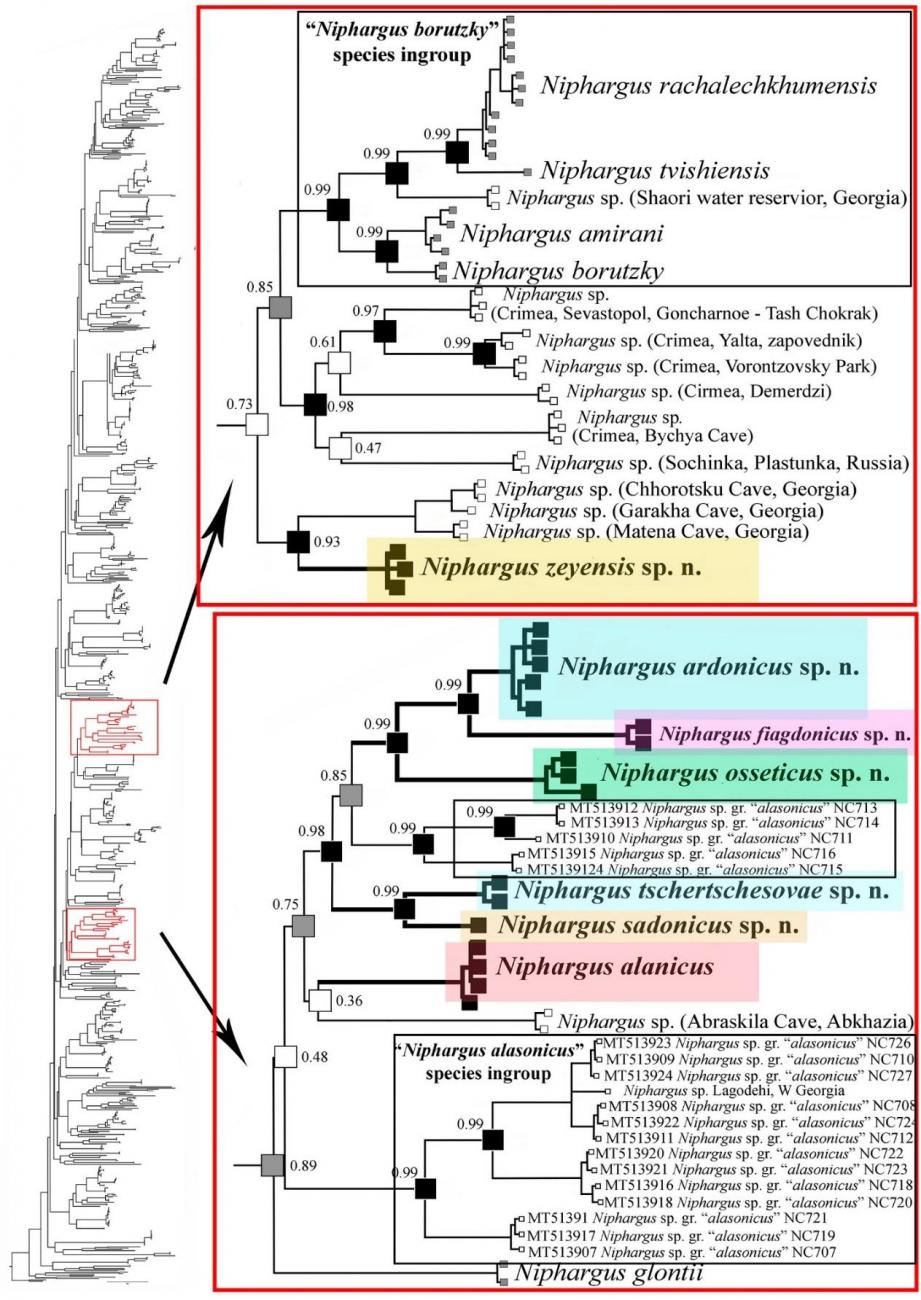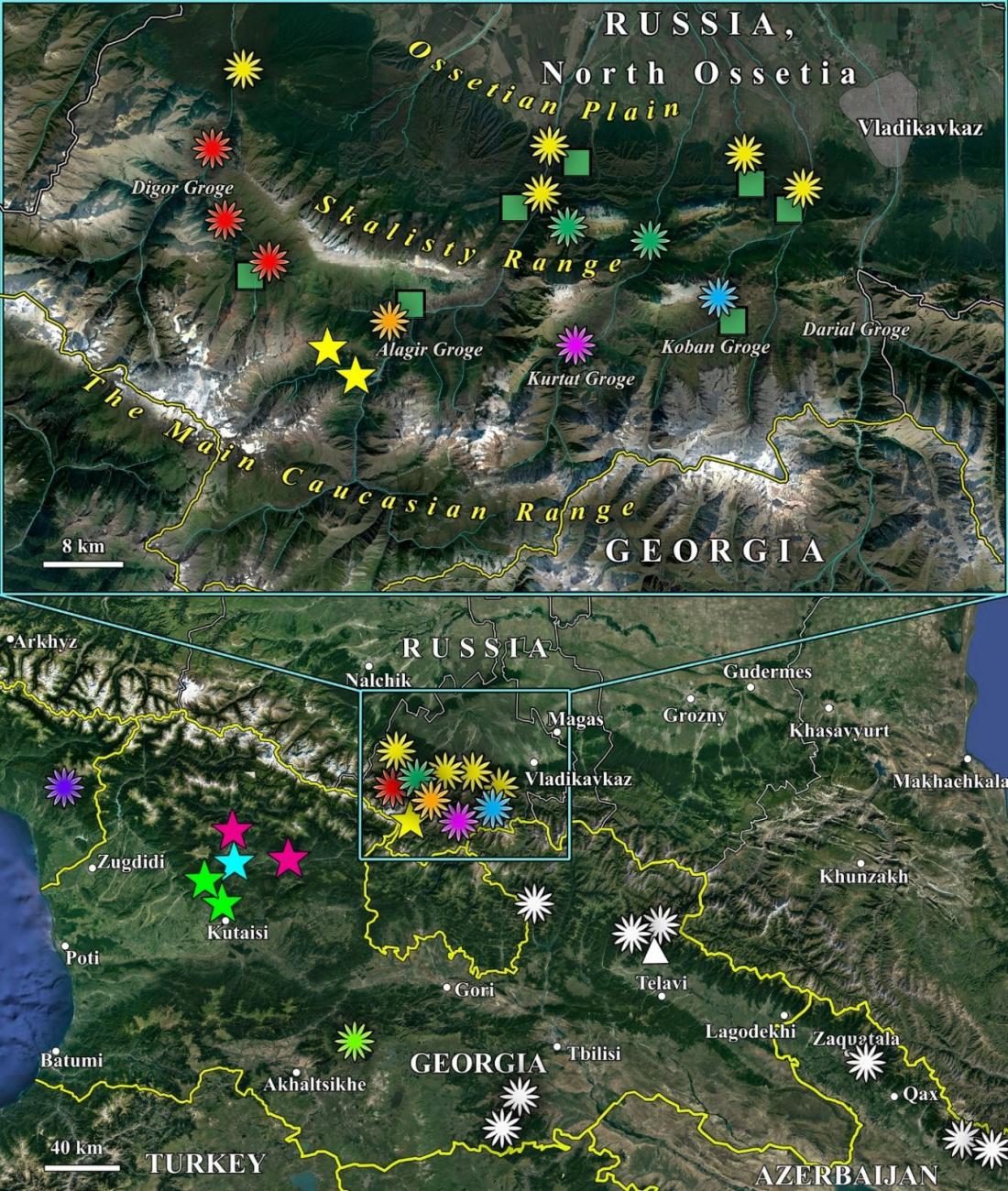
Currently, groundwater is considered one of the most unexplored and underestimated, but nevertheless, a key ecosystem in the world. The study of groundwater in the Caucasus and, in particular, the use of these data for both fundamental and applied research, for example, to search for sources of clean drinking water, is an important area of scientific activity and is relevant for all territories of the Caucasus.
The IEE RAS staff presented a review and partial revision of the diversity of freshwater hyporheic/stygobiotic crustaceans in the Republic of North Ossetia-Alania, North Caucasus.
Previously, two species of the genus Proasellus Dudich, 1925 (Isopoda, Asellidae), P. uallagirus Palatov & Sokolova, 2020 and P. irystonicus Palatov & Sokolova, 2020, and one species of the genus Niphargus Schiödte, 1849 (Amphipoda, Niphargidae), N. alanicus Marin & Palatov, 2021, were known from this area. However, a more extensive sampling and a complete examination of the available material using an integrative approach showed that only one species of the genus occurs in this area (the second species is synonymized), while the diversity of the genus Niphargus was significantly higher than previously known. This paper describes six new species of the genus Niphargus from hyporheic/stygobiotic habitats of the Republic of North Ossetia–Alania, and discusses their phylogenetic relationships, ecology, and known distribution. Interspecific distances (p-distances), based on the mtDNA COI gene marker, between the studied species from North Ossetia exceed 9-19%, which also indicates their long-term isolation from each other, at least 3.6-7.6 million years ago.

Geographically, it has been established that Proasellus uallagirus Palatov & Sokolova, 2020 in the republic is a fairly widespread species that is found in the water resources of large mountain gorges: the Urukh River (Digorskoye Gorge), Ardon (Alagirskoye) and Gizeldon (Kobanskoye), where it lives in a wide range of altitudes, from 700 to 1800 meters above sea level. However, at present, it is not found in the Fiagdon River basin (Kurtatinsky District) and the upper reaches of the Terek (Daryal Gorge).
At the same time, it is specified that all nifargus are local endemics, and are currently found only in the republic. They are associated with underground aquatic habitats in various gorges/river valleys in the Republic of North Ossetia-Alania: Niphargus alanicus Marin & Palatov, 2021 is known from the Sardidon and Dargonkom River valleys (see Marin & Palatov, 2021; this study), Niphargus ardonicus sp. n. – Ardon, Mayramadag and Gizeldon River valleys, Niphargus sadonicus sp. n. – Sadon River valley, a tributary of the Ardon River, Niphargus tschertschesovae sp. n. – Gizeldon River valley and Niphargus zeyensis sp. n. from the Tseydon River basin (Tsey Gorge). Two species, Niphargus fiagdonicus sp. n. and Niphargus osseticus sp. n., found in different parts (upper and lower, branched) of the Fiagdon River valley (Fiagdon Gorge), as well as Niphargus tschertschesovae sp. n. and Niphargus ardonicus sp. n., were also found in different (mountainous) areas (upper and lower parts, respectively) of the Gizeldon River. At the same time, in none of the studied habitats was more than one species of the genus Niphargus found.
The revealed level of endemism of the subterranean fauna significantly exceeds the terrestrial fauna of this region, which consists mainly of widespread species. Most of the studied hyporheic/stygobiotic crustaceans diverged from their relatives starting from the late Miocene, approximately 8-5.8 million years ago, and have survived there to the present day. According to the obtained data, we confirm that the riverine habitats in the mountainous part of the Republic of North Ossetia-Alania can be considered as post-Pliocene glacial refugia, the first known on the northern slope of the Greater Caucasus Mountain Range.
The authors also believe that undescribed species belonging to both of these two genera of crustaceans, as well as representatives of other hyporheic/stygobiotic and other subterranean animals, may still exist on the territory of the Republic of North Ossetia-Alania. Also, the diversity of the Republic of North Ossetia-Alania stands out noticeably from other settlements on the northern slope of the Caucasus Mountains (North Caucasus). Currently, on the northern slope of the Caucasus Mountains, hyporheic/stygobiotic crustaceans are known only from the territory of Krasnodar Krai (e.g. Niphargus ciscaucasicus Marin & Palatov, 2019) (and the Republic of Adygea (unpublished data), while no such animal has been found in nearby mountainous areas such as Stavropol Krai, the Republic of Ingushetia, Kabardino-Balkaria, Karachay-Cherkessia or the Chechen Republic (Chechnya). It is very likely that more thorough and extensive fieldwork is also needed in these areas.
The work carried out in the Republic of North Ossetia-Alania, as well as the discovery of new species here, once again confirms that in the Miocene, representatives of the genus Niphargus were much more widespread in the Ciscaucasian Plain and the territory north of the Greater Caucasus Range. The mountain gorges of this region provided a safe habitat for hyporheic/stygobiotic fauna during the climatic (temperature) fluctuations of the Pleistocene (Quaternary) ice ages (2.6 million years ago - present), and especially during the Last Glacial Maximum (LGM) (23-18 thousand years ago), which allowed them to survive to this day.
It is worth emphasizing once again that underground species have a narrow localization and require strict protection and attention to their habitat, since the destruction of the population leads to the loss of unique ancient genetic lines that cannot be restored.
One of the species is named in honor of the head of the Department of Zoology and Bioecology of the North Ossetian State University, Doctor of Biological Sciences, Professor, Susanna Konstantinovna Cherchesova, a hydrobiologist and entomologist known far beyond the borders of the Republic.
The article is published in the international peer-reviewed journal Water: The Diversity of Freshwater Stygobiotic Crustaceans in the Republic of North Ossetia–Alania Provides New Evidence for the Existence of an Ancient Glacial Refugium in the North Caucasus Region by Ivan N. Marin and Dmitry M. Palatov, Water 2024, 16(9), 1212; https://doi.org/10.3390/w16091212.
